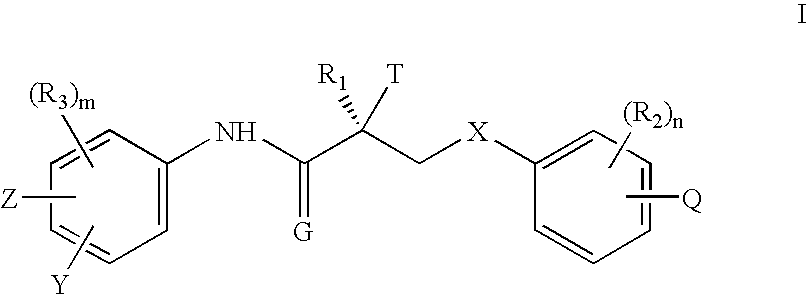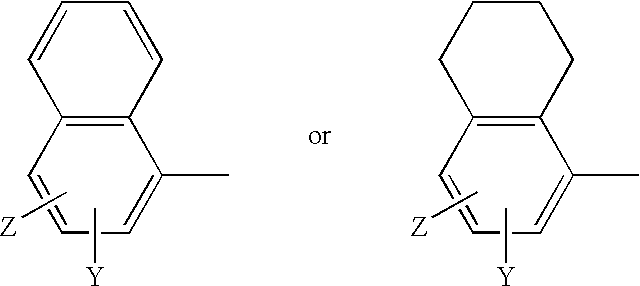Irreversible selective androgen receptor modulators and methods of use thereof
a selective androgen receptor and modulator technology, applied in the field of androgen receptor targeting agents, can solve the problems of no cure, no anti-androgenic activity, and poor prognosis, and achieve the effects of reducing libido, affecting mood and cognition, and affecting sexual sensitivity
- Summary
- Abstract
- Description
- Claims
- Application Information
AI Technical Summary
Benefits of technology
Problems solved by technology
Method used
Image
Examples
example 1
Cytotoxicity of Compounds in Different Cell Lines
[0504] The IC50s of R-CTF-T-CA-1, R-CTF-T-BA-1, S-NTBA, Compound V, 5-FU and Taxol in prostate cancer cell lines (DU 145, PC-3, TSU, PPC-1 and LNCaP), in other cancer cell lines (TCCSUP, HT-29) and in a control cell line (CV-1) are shown in Tables 2A and 2B, and in FIG. 1. The results demonstrate that Compound V is highly selective for the AR-expressing LNCaP prostate cancer cell line, compared with other prostate cancer cell lines which do not express the AR, and with non-prostate cancer cell lines. These results demonstrate the potential of Compound V as a useful agent in prostate cancer monotherapy.
TABLE 2AProstate Cancer Cell LinesNameStructureMWR-CTF-T- CA-1 (μM)471.88R-CIF-T- BA-1 (μM)516.33S-NTBA (μM)371.11Compound V (μM)421.395-FU130.1(μM)Taxol853.9(nM)Prostate Cancer Cell LinesNameDU145PC-3TSUPPC-1LNCaPR-CTF-T-2.6 ± 0.16.1 ± 0.51.5 ± 0.22.5 ± 0.11.1 ± 0.2CA-1(μM)R-CIF-T-3.1 ± 0.12.6 ± 0.10.6 ± 0.11.3 ± 0.13.2 ± 0.4BA-1(μM)...
example 2
Cytotoxicity of Compounds in LNCap Cell Line
[0506] The IC50s of R-CTF-T-CA-1, R-CTF-T-BA-1, S-NTBA, and Compound V in AR-expressing LNCaP Prostate Cancer cell line and in a control cell line (CV-1) are shown in Table 3 and in FIG. 2 (LNCaP) and FIG. 3 (CV-1). Following 24 hr treatment, the IC50s of R-CTF-BA-1, R-CTF-T-CA1, S-NTBA and Compound V in the LNCaP cell line were 11.2 μM, 3.5 μM, 4.4 μM and 39.6 μM, respectively. Following a 6 day treatment, the IC50s of R-CTF-BA-1, R-CTF-T-CA1, S-NTBA and Compound V in the LNCaP cell line were 8.1 μM, 1.7 μM, 2.1 μM and 33.6 μM, respectively. This is compared with the results in a control CV-1 cell line, in which the IC50s of R-CTF-BA-1, R-CTF-T-CA1, and S-NTBA following a 4 day treatment were 13.9 μM, 4.2 μM, and 4.9 μM respectively (Compound V-NA). The results demonstrate that Compound V is highly selective for the AR-expressing LNCaP prostate cancer cell line, compared with a control cell line. These results demonstrate the potential o...
example 3
Cytotoxicity of Compounds in PC-3 Cell Line
[0507] The IC50s of R-CTF-T-CA-1, R-CTF-T-BA-1, S-NTBA, and 5-FU in PC-3 Prostatic metastatic bone marrow cell line are shown in Table 4 and in FIG. 4. Following 24 hr treatment, the IC50s of R-CTF-BA-1, R-CTF-T-CA1, S-NTBA and 5-FU FU were 22.1 μM, 5.8 μM, >50 μM and 22-50 μM, respectively. Following a 4 day treatment, the IC50s of R-CTF-BA-1, R-CTF-T-CA1, S-NTBA and 5-FU were 16.8 μM, 4.3 μM, 18.0 μM and 10.9 μM, respectively.
TABLE 4Summary of IC50s of R-CTF-Ts on PC-3 from different treatmentsIC50 (μM)24 hr4 dayNameStructuretreatmenttreatmentR-CTF-T-BA-122.116.8R-CTF-T-CA-15.84.3S-NTBA>5018.05-FU20-5010.9
PUM
 Login to View More
Login to View More Abstract
Description
Claims
Application Information
 Login to View More
Login to View More - R&D
- Intellectual Property
- Life Sciences
- Materials
- Tech Scout
- Unparalleled Data Quality
- Higher Quality Content
- 60% Fewer Hallucinations
Browse by: Latest US Patents, China's latest patents, Technical Efficacy Thesaurus, Application Domain, Technology Topic, Popular Technical Reports.
© 2025 PatSnap. All rights reserved.Legal|Privacy policy|Modern Slavery Act Transparency Statement|Sitemap|About US| Contact US: help@patsnap.com



